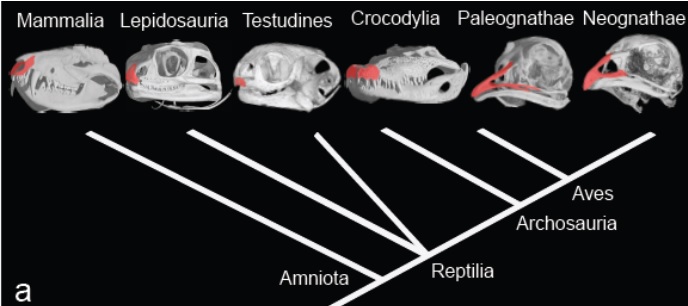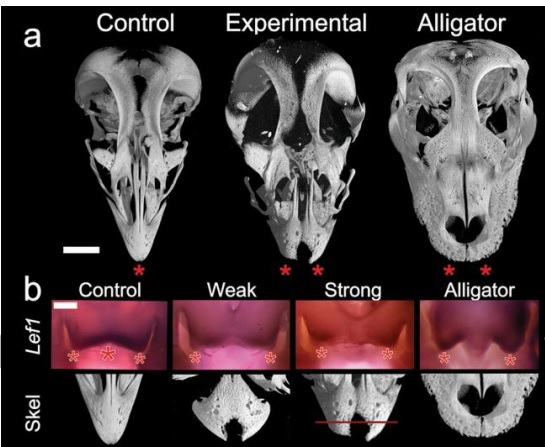One really elegant piece of evidence for evolution is “reversing evolution”. This does a couple of things. First, it allows us to identify the genes involved in the transition from one species (or higher) to another. Second, it shows that the idea of common descent is true. Third, it can be a prediction of evolutionary theory that is testable and falsifiable.
In general, this is both technically and ethically difficult. Technically, because we have to identify the genes that make an organism what it is, then find a way to turn them off. Ethically, because this isn’t Jurassic Park. The idea of creating a dinosaur from a bird or a Smilodon is fraught with peril. As Ian Malcolm said, “Just because we can, doesn’t mean we should.” The research I report on today has dealt with the technical issues and only looked at the resulting organism as an embryo with no intention of growing it to hatching.
The paper is “A molecular mechanism for the origin of a key evolutionary innovation, the bird beak and palate, revealed by an integrative approach to major transitions in vertebrate history” by Bhart-Anjan S. Bhullar et. al.
The authors used an integrative approach, meaning that they used paleontology data, molecular data, and comparative anatomy. First, they look at the fossil history of the bird beak. This is notable as the bird beak appeared in the fossil record just before the end of the Cretaceous period (and the opening of new niches). Birds are now one of the most successful vertebrates with over 10,000 species.
The bird beak is a fusion of elongated upper jaw bones. In humans these specific upper jaw bones are fused with the rest of the upper jaw and the upper incisors grow from them. In reptiles, they tend to form an extension of the upper jaw and the two bones are not fused together. This is a major difference between reptiles and birds.

This diagram shows the part of the upper jaw bone(s) we are talking about (in red) and the relationship of these groups. From left to right, they are mammals, lizards, turtles, crocodiles, ratites and tinamous, and all other modern birds.
Some early not-quite birds show the beginning of an enlarged upper jaw bone, that will eventually become a beak. This occurs in a particular group called Ornithurae, which is defined as all modern birds and everything more closely related to modern birds than Archaeopteryx. Anatomically, everything in the Ornithurae group has a short tail, unlike Archaeopteryx which has a long tail like a dinosaur.
This upper jaw bone forms, in the embryo, from a particular area of the neural crest, which I mentioned in some cat research fairly recently and in a post by Dr. Janis on whales). The researchers compared the development of the embryos in birds, alligators, turtles, and lizards to find out what genes were active during each stage of the jaw development. They found that two biochemical signalling processes were mainly responsible for the beak. The details aren’t important, but the Sonic hedgehog protein is involved, so you know it’s awesome.
The next step was to try and recreate the ancestral condition, by silencing the genes that cause those signalling pathways to work. The researchers injected embryos with molecules to inhibit the molecules used to develop the beak. They compared the skeletons of the embryos with the various inhibitory chemicals against normal chicken embryos.
They found the the chicken embryos with inhibit genes had, not beaks, but separate, rounded upper jaw bones. These were very similar to alligator embryos.

Part a of this figure shows the modern, unmodified chicken (control), the ancestral condition in a modern alligator (Alligator) and the chicken embryo that was modified with the chemical suppressants (Experimental). Notice how, instead of a single, fused bone (at the bottom of each image), the experimental embryo has an obvious split between two bones and are very similar to the alligator’s nose.
Part b of the figure shows the different experimental methods and how they affect the growth of the upper jaw bone(s).
The authors state that this is a minor, but novel change of gene expression which has resulted in not a long mouth with teeth, but instead a beak. This is not the whole genetic story of the development of the beak, but it is an integral part of the story. Like feathers, the genetics and molecules needed to form the beak were present long before the first birds appeared.
The researchers looked at the presently understood evolutionary and development history of birds and predicted that changing some of the developmental process might result in a modern bird looking (at least partially) like an ancestral organism. Now, I should state that a modern alligator or crocodile is not an ancestral organism to any modern bird. However, the crocodiles and alligators, unlike birds, have retained their ancestral form for hundreds of millions of years. Since we don’t have much in the way of fossilized crocodile embryos, we use modern embryos to compare to.
In addition, we have shown that just as the fossil record can provide developmental hypotheses, graded phenotypes resulting from restoration of the inferred ancestral developmental patterns can, in return, predict undiscovered transitional morphologies in the fossil record. For instance, we expect that stem avian palatines, as they are discovered and described, will resemble the gap-bridging palatal phenotypes we experimentally generated in chicken embryos.
This last bit is another prediction formed using an evolutionary understanding of both development and the fossil record. I expect that it will be shown to be correct soon enough. I look forward to those results.
